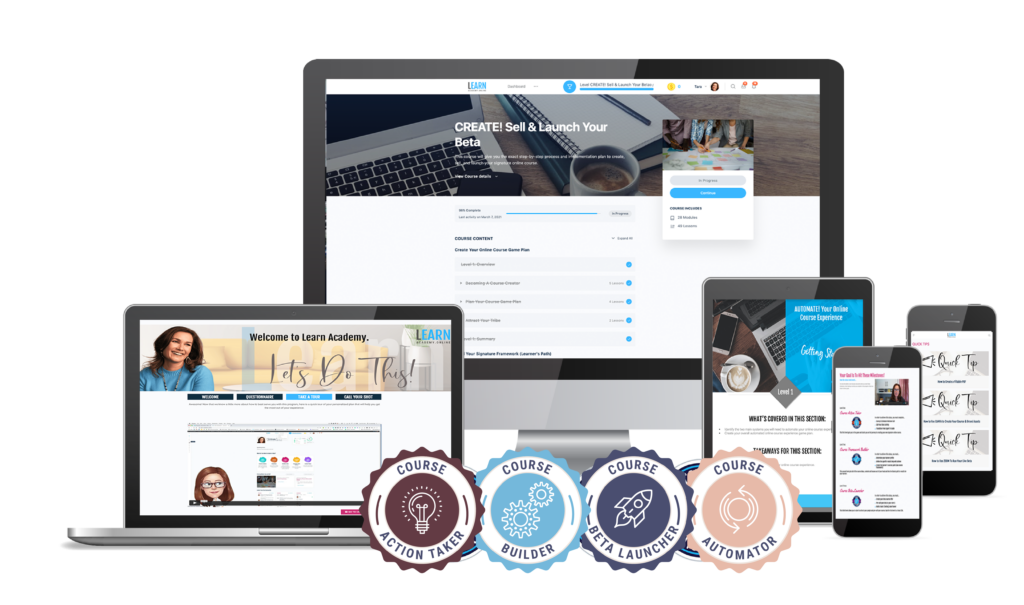Why Most Training Programs Fail (And How Learning Experience Design Fixes It)
If you’ve ever sat through mandatory training that felt like watching paint dry, you’re not alone.
In fact, according to Training Magazine’s 2024 Industry Report, U.S. organizations spent $98 billion on training in 2024, yet research from Skillademia indicates that only 10% of corporate training spending delivers real results. The problem isn’t lack of investment—it’s poor learning experience design.
The problem isn’t lack of investment—it’s poor learning experience design.
Traditional training treats learners like empty vessels waiting to be filled with information.
Learning experience design flips this model entirely, focusing on creating transformative experiences that drive specific behavioral changes and measurable business outcomes.
The difference is profound. Companies that implement strategic learning experience design see 218% higher revenue per employee and 24% higher profit margins compared to those using traditional training methods.
What Is Learning Experience Design?
Learning experience design (LXD) is the systematic approach to creating experiences that engage learners emotionally, cognitively, and behaviorally to achieve specific performance outcomes.
Unlike instructional design, which focuses primarily on content organization and delivery, learning experience design prioritizes the learner’s journey, emotional engagement, and real-world application.
At its core, learning experience design combines principles from:
- Cognitive psychology and learning science
- User experience (UX) design
- Behavioral economics
- Performance improvement methodologies
This multidisciplinary approach ensures that learning experiences don’t just inform—they transform.
The Business Case for Strategic Learning Experience Design
Forward-thinking organizations recognize that learning experience design isn’t just an HR initiative—it’s a strategic business imperative.
Here’s why:
Revenue Impact
Companies with comprehensive learning experience design programs report 37% higher sales productivity and 92% more likely to develop novel products and processes.
When employees can quickly apply new skills to drive business results, revenue follows.
Employee Retention
Organizations that invest in well-designed learning experiences see 40% lower turnover rates.
Employees stay longer when they feel their growth is intentionally designed and supported.
Competitive Advantage
In rapidly evolving markets, the ability to quickly upskill teams through effective learning experiences becomes a critical differentiator.
Companies with superior learning experience design adapt 5x faster to market changes.
Customer Satisfaction
When customer-facing employees receive training through well-designed learning experiences, customer satisfaction scores increase by an average of 32%.
The quality of internal learning directly impacts external relationships.
The 7-Stage Learning Experience Design Framework
After working with hundreds of organizations to transform their training programs, I’ve developed a proven framework that consistently delivers results.
This systematic approach ensures every learning experience drives specific business outcomes while maintaining high engagement levels.
Stage 1: Discover the business need and performance gap – what do you need people to do?
Before designing any learning experience, you must clearly identify the performance gap you’re trying to close.
This isn’t about what people don’t know—it’s about what they’re not doing that’s impacting business results.
Key Questions to Answer:
- What specific behaviors need to change?
- What business metrics will improve when these behaviors change?
- What’s currently preventing the desired behaviors?
- How will you measure behavior change over time?
Action Step: Conduct stakeholder interviews with managers, top performers, and struggling employees to identify the root causes of performance gaps.
Often, the issue isn’t lack of knowledge—it’s lack of motivation, unclear expectations, or system barriers.
Stage 2: Learner Journey Mapping
Effective learning experience design starts with deep empathy for your learners.
Create detailed personas that capture not just demographics, but psychological drivers, pain points, and preferred learning modalities.
Essential Persona Elements:
- Current skill level and experience
- Motivation drivers and barriers
- Available time and attention spans
- Technology comfort and access
- Workplace pressures and constraints
- Learning preferences and past experiences
Map the complete learner journey from initial awareness through mastery application. Identify emotional highs and lows, potential friction points, and opportunities for engagement.
Stage 3: Uncover Outcome-Focused and Measurable Outcomes
Traditional training objectives focus on knowledge acquisition (“Participants will understand…”).
Learning experience design objectives focus on performance outcomes (“Participants will consistently demonstrate…”).
The PERFORMS Framework:
- Performance-based: Focuses on observable behaviors
- Engagement-driven: Maintains learner motivation throughout
- Relevant: Directly connects to job responsibilities
- Frequency-specific: Defines how often behaviors should occur
- Outcome-linked: Ties to specific business metrics
- Realistically challenging: Stretches capabilities without overwhelming
- Measurable: Includes specific success criteria
- Supported: Provides ongoing reinforcement mechanisms
Stage 4: Design a Multi-Modal Experience Architecture
The most effective learning experiences combine multiple modalities to accommodate different learning preferences and reinforce key messages.
Learning experience design leverages the science of spaced repetition and varied practice to maximize retention and application.
Core Modality Options:
- Synchronous Learning: Live workshops, virtual sessions, mentoring
- Asynchronous Learning: Self-paced modules, videos, reading materials
- Social Learning: Peer discussions, case study groups, communities of practice
- Experiential Learning: Simulations, role-plays, real-world projects
- Microlearning: Just-in-time resources, quick reference guides
- Gamified Elements: Points, badges, leaderboards, challenges
The key is strategic sequencing. Start with foundational learning through asynchronous methods, reinforce through social learning, practice through experiential activities, and maintain through micro touchpoints.
Stage 5: Optimize Cognitive Load
Human working memory can only process 7±2 pieces of information simultaneously. Learning experience design respects these cognitive limitations by chunking information, scaffolding complexity, and providing appropriate cognitive breaks.
Cognitive Load Principles:
- Intrinsic Load: The inherent difficulty of the material being learned
- Extraneous Load: Mental effort wasted on poorly designed instruction
- Germane Load: Mental effort devoted to processing and constructing understanding
Optimize learning experiences by minimizing extraneous load (confusing navigation, irrelevant information, poor visual design) while appropriately managing intrinsic load through progressive complexity.
Stage 6: Integrate Active & Direct Application
The most critical element of learning experience design is building in multiple opportunities for learners to actively apply new knowledge to their specific work context. Passive consumption leads to forgetting; active application leads to mastery.
Application Integration Strategies:
- Scenario-Based Practice: Present realistic workplace situations requiring new skills
- Case Study Analysis: Use real examples from learners’ industry or organization
- Action Learning Projects: Assign projects that solve actual business problems
- Peer Coaching Sessions: Partner learners to practice and provide feedback
- Reflection Journals: Encourage documentation of application attempts and results
- Manager Integration: Involve supervisors in supporting and reinforcing application
Build application opportunities throughout the learning experience, not just at the end.
Every 10-15 minutes of new content should be followed by 5-10 minutes of active application.
Stage 7: Performance Support and Reinforcement
Learning doesn’t end when the formal program concludes. Effective learning experience design includes ongoing performance support that helps learners maintain and improve their skills over time.
Reinforcement Mechanisms:
- Job Aids: Quick reference materials for complex processes
- Peer Networks: Ongoing communities for sharing challenges and solutions
- Micro-Coaching: Brief, focused sessions addressing specific skill gaps
- Progress Tracking: Systems for monitoring behavior change over time
- Recognition Programs: Acknowledging successful application and improvement
- Refresher Sessions: Periodic skill updates and advanced applications
Advanced Learning Experience Design Techniques
Emotional Engagement Strategies
Learning experience design recognizes that emotions drive both attention and retention. Design experiences that create positive emotional connections with the content and process.
Emotional Design Elements:
- Storytelling: Frame learning within compelling narratives
- Personal Relevance: Connect content to learners’ goals and challenges
- Achievement Systems: Create frequent opportunities for success and recognition
- Social Connection: Facilitate meaningful interactions with peers and experts
- Autonomy Support: Provide choices in learning paths and pace
Behavioral Science Integration
Leverage insights from behavioral economics and psychology to design learning experiences that naturally encourage behavior change.
Key Behavioral Principles:
- Default Options: Make desired behaviors the easiest choice
- Loss Aversion: Frame benefits in terms of avoiding negative outcomes
- Social Proof: Highlight how peers successfully apply new skills
- Implementation Intentions: Help learners plan specific when/where/how applications
- Commitment Devices: Create accountability mechanisms for behavior change
Technology-Enhanced Learning Experiences
Modern learning experience design strategically incorporates technology to enhance, not replace, human connection and practical application.
Technology Integration Guidelines:
- Mobile-First Design: Ensure accessibility across devices
- Analytics Integration: Track engagement and progress data
- Personalization Engines: Adapt content based on learner performance
- Virtual Reality Applications: Provide safe spaces for high-risk skill practice
- Artificial Intelligence: Offer personalized coaching and feedback
Measuring Learning Experience Design Success
Effective measurement goes beyond participant satisfaction scores to track actual behavior change and business impact.
The Four Levels of Learning Experience Measurement
Level 1: Engagement Metrics
- Time spent in learning activities
- Completion rates across modules
- Participation in optional elements
- Peer interaction frequency
Level 2: Skill Acquisition
- Assessment scores and improvement
- Skill demonstration quality
- Confidence level changes
- Retention over time
Level 3: Behavior Change
- On-the-job application frequency
- Quality of skill application
- Manager observations of change
- Self-reported behavior modifications
Level 4: Business Impact
- Performance metric improvements
- Revenue or cost impact
- Customer satisfaction changes
- Innovation and improvement contributions
Advanced Analytics for Learning Experience Design
Modern learning experience design leverages data analytics to continuously improve program effectiveness.
Key Analytics Applications:
- Learning Path Optimization: Identify most effective sequence and pacing
- Content Effectiveness: Determine which materials drive best outcomes
- Learner Segmentation: Customize experiences based on learning patterns
- Predictive Modeling: Identify learners at risk of non-completion
- ROI Calculation: Quantify business value of learning investments
Common Learning Experience Design Mistakes to Avoid
Information Overload
Many organizations try to pack too much content into learning experiences, overwhelming learners and reducing effectiveness. Focus on the 20% of information that drives 80% of performance improvement.
Lack of Context
Generic, one-size-fits-all approaches fail because they don’t connect to learners’ specific situations. Always customize examples, scenarios, and applications to the learner’s context.
Missing Application Opportunities
Learning experiences that focus solely on knowledge transfer without providing application practice result in poor skill retention and minimal behavior change.
Inadequate Reinforcement
Front-loading all learning into intensive sessions without ongoing support leads to rapid skill decay. Design reinforcement throughout the performance improvement journey.
Poor Manager Integration
When managers aren’t involved in supporting and reinforcing learning, application rates drop dramatically. Include manager enablement as part of every learning experience design.
The Future of Learning Experience Design
As we move forward, learning experience design will continue evolving to meet changing workforce needs and leverage emerging technologies.
Emerging Trends
Adaptive Learning Systems: AI-powered platforms that adjust content and pacing based on individual learning patterns and performance data.
Immersive Technologies: Virtual and augmented reality creating safe spaces for high-stakes skill practice and complex scenario training.
Neuroscience Integration: Brain science insights informing optimal timing, spacing, and modality selection for different types of learning.
Continuous Learning Ecosystems: Moving from event-based training to ongoing, embedded learning experiences that adapt to changing job requirements.
Your Next Steps in Learning Experience Design
Ready to transform your organization’s approach to learning and development? Here’s your action plan:
Week 1: Assessment and Planning
- Conduct a learning experience design audit of current programs
- Identify top three performance gaps with highest business impact
- Survey learners about current training effectiveness and preferences
Week 2: Framework Implementation
- Apply the 7-stage framework to one high-priority learning initiative
- Create detailed learner personas for your target audience
- Map the complete learner journey from awareness to mastery
Week 3: Pilot Development
- Design a pilot learning experience using the principles outlined
- Build in multiple application opportunities and reinforcement mechanisms
- Establish measurement systems for all four levels of evaluation
Week 4: Launch and Iteration
- Deploy the pilot with a small group of engaged learners
- Collect detailed feedback and performance data
- Refine the experience based on learner responses and early results
Learning experience design isn’t just about creating better training—it’s about building organizational capability that drives sustainable competitive advantage. When you design learning experiences that truly transform behavior and deliver measurable business results, you create value that compounds over time.
The organizations that master learning experience design will have workforces that adapt faster, perform better, and drive more innovation than their competitors. The question isn’t whether you can afford to invest in learning experience design—it’s whether you can afford not to.
Start with one program, apply these principles systematically, measure relentlessly, and iterate continuously. Your learners—and your business results—will thank you.
If you are interested in bringing this approach to your business, set up a discovery call with Tara.







